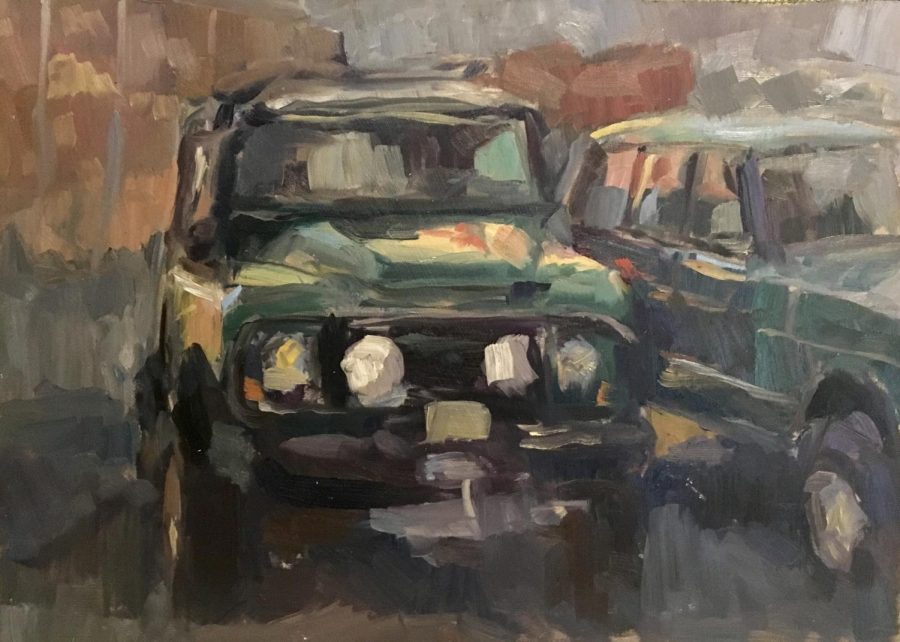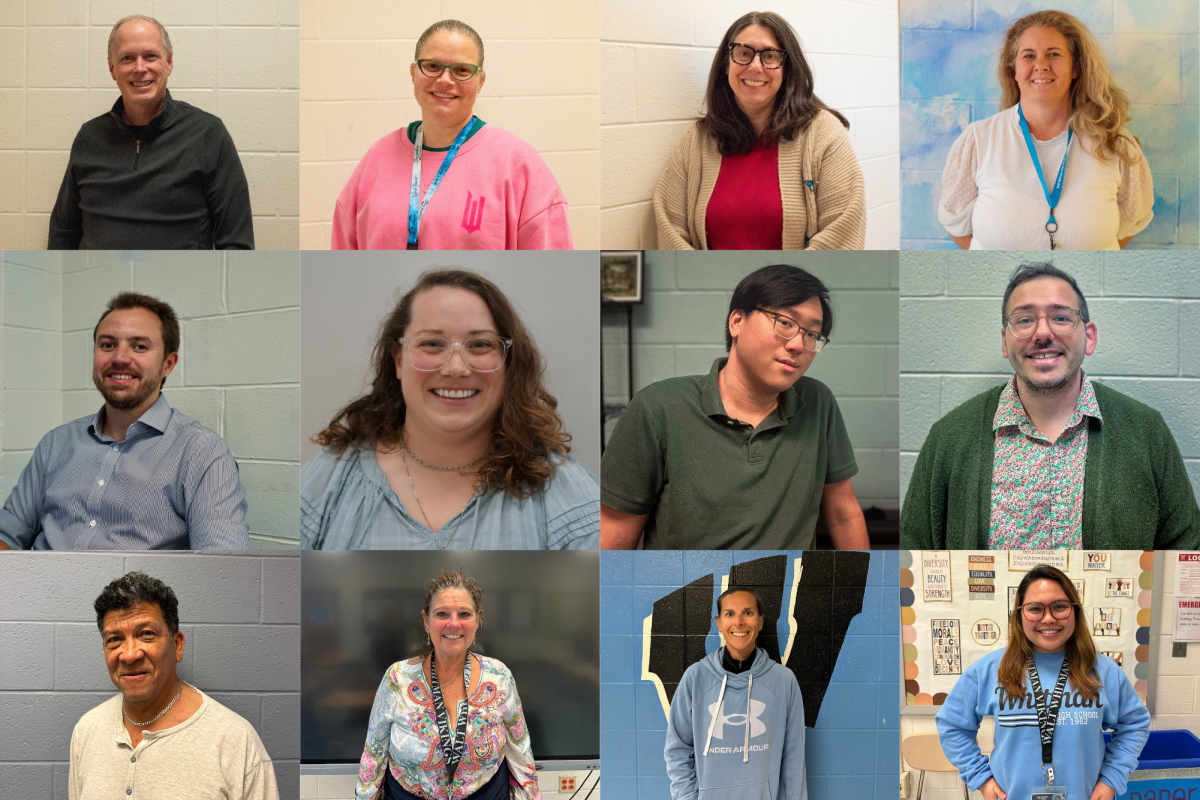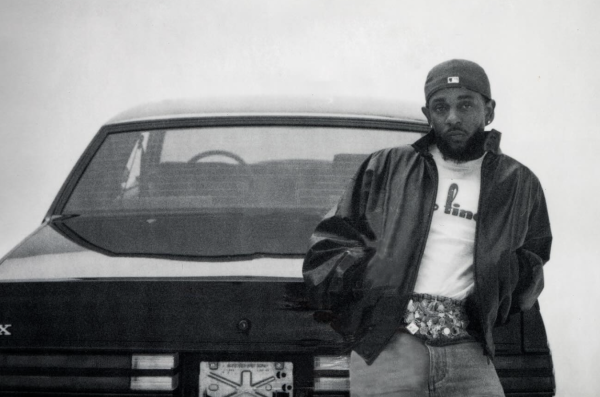All revved up
Junior Nicholas Pyle drives creativity by painting cars
One of junior Nicholas Pyle’s paintings. Nicholas hopes to go into automotive design in the future.
February 24, 2020
On a freezing Saturday afternoon in the middle of December, I’m bundled up in the middle of the woods, trying to stay warm. Next to me, junior Nicholas Pyle is standing with his completely blank masonite board, visualizing the landscape I’ve come to watch him paint. Only 90 minutes later, dozens of differently colored, temperate paints gather in layers upon layers of strokes to form the scenery surrounding us. He was so focused when painting his landscape that he forgot his gloves were in his pants pocket — all while I’m shivering in my parka.
When Nicholas began this landscape painting, he sketched an outline of the surrounding forest — trees, the creek, a bridge, large rocks and the trail — with his favorite green half-broken paintbrush on his masonite board. With each stroke that followed, I noticed how Nicholas held his paintbrush unevenly, splattering the paint onto the board.
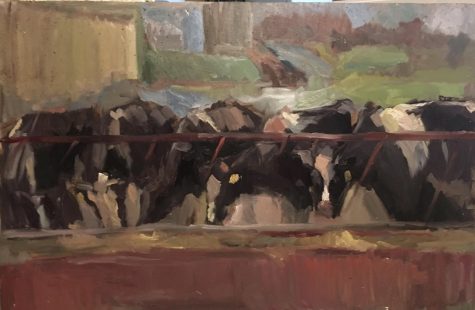
Nicholas painted this landscape during an art workshop in Frederick, Maryland.
At first, it was hard to tell what he was painting as the murky blobs spread across the surface of the board. But as the final brush strokes landed, the elements and colors of his landscape came together as one; a visage of the densely wooded area with the rocky banks of the Cabin John Creek and the one-lane bridge on McArthur Blvd cutting through it all appeared suddenly.
“My paintings don’t really look like what I’m painting until I’m done,” Nicholas said. “They don’t look how they should look at first, but I eventually pull it together for the final product.
As a student artist, Nicholas said that he isn’t very different from others like him in terms of execution or skill — but his imagination is unique. He sees everything in the world in a different color than it appears naturally, he said.
When Nicholas looks at the white walls in the Whitman hallways, he sees their base colors, but he also sees their shadows and what colors they create. To the casual observer, the walls appear white with grey shadows, but Nicholas would see peachy pink and even some green. The colors, he says, “compliment each other” to create an overall effect.
Nicholas has used this vivid imagination to compete in various art shows and earn free admission to an art summer program at the College of Creative Studies in Detroit, Michigan, last summer. He was one of only 15 students internationally that was accepted into this prestigious program.
Nicholas and the other students in the program spent three weeks designing “abstract” cars. Nicholas said it was special to meet others his age who have also been passionate about visual art and car design, another focus for him.
“He’s been drawing and painting since the first time I met him way back in first grade,” junior Finn Martin said. “The times when he isn’t at school or hanging out with his friends he’ll be painting.”
Nicholas’ interest in art was always closely tied to an obsession with cars. He first became interested in cars at age four when his uncle brought him car magazines to read, like Car and Driver, Road and Track, and Autoweek.
As early as preschool, Nicholas could name every single type of car, his mother, Alexandra Freeman said. Nicholas’ love for cars soon grew into an appreciation for their artistic design, he said. Around the same time he started to be interested in cars, he would frequently play a game on paper in which he had to customize and design a car, adding different accessories to the car like exterior color, tires, spoilers and a hood scoop.
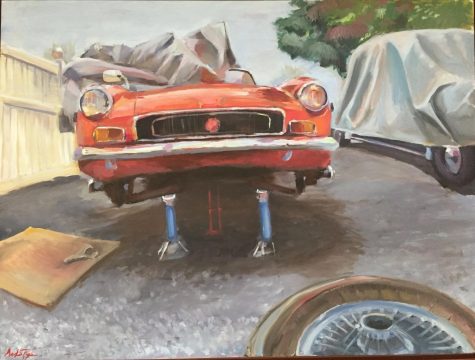
Another of Nicholas’ car paintings.
Because of Nicholas’ interest in cars, his father, also a car enthusiast, bought an orange 1971 MG MGB, a “classic” British car, to teach Nicholas more about how cars worked.
Nicholas’ family loved the old-fashioned car so much that they later bought another near half-century old car: a blue 1971 Volkswagen Beetle. The inside of the car is small and cramped, but Nicholas still loves taking family rides in it.
“When people look at a car, they don’t see the technical specifications of the car,” Nicholas said. “They see the overall shape of the car, which makes the design a really important aspect.”
Excited by Nicholas’ interest in art and drawing, Alexandra signed him up when he was 12 for painting classes at the Yellow Barn, an art gallery and studio in Glen Echo. At the Yellow Barn, he began to develop his art skills in earnest, Nicholas said.
As his skills started to become more refined around the age of 13, Nicholas began taking on commissioned paintings, normally selling the art for between $100 and $150.
A coworker of Alexandra’s who has known Nicholas since he was a little boy, Dick Darnell, bought the first painting that Nicholas ever sold, “Cuban Blue,” for around $100. Darnell said people always gravitate toward the painting, which is hung up in his home, and ask him about it.
“Even this painting, an earlier one of his, is incredible and has so much detail,” Darnell said. “As an artist, I think he is in the line of some of the great painters. He has a gift that is rare in my opinion.”
Now, Nicholas takes figure painting classes where he focuses on painting people. He also interns at the Yellow Barn a few days a week, helping to set up and prepare for the various art shows that occur there throughout the year. Around a dozen people have now commissioned paintings from Nicholas through email or mutual friends, and he even has a website for potential customers to browse through some of his work. Once strictly a car painter, Nicholas now often paints portraits of animals like customers’ dogs, something that is frequently requested. All you think about is painting and nothing else. I can forget about school and all of my other problems.
In addition to painting different subjects, Nicholas now also enjoys painting in a variety of settings, especially outdoors. He recently completed an art workshop in Frederick where he had to paint cows, making it the first time he painted something that wasn’t still.
“It’s so nice painting outside,” Nicholas said. “All you think about is painting and nothing else. I can forget about school and all of my other problems.”
Outside of school, Nicholas tries to paint outdoors at least once a week, normally at the Cabin John Creek or near the Potomac River, and typically paints cars inside once or twice a week. When he paints, he never finds himself nervous or confused, he just dives right in, he said.
“It’s one of the reasons why I like painting is because I don’t have to think to get myself ready,” Nicholas said. “It’s not as much thinking; it’s a different sort of logic.”
Nicholas finds inspiration from the creative community of artists at Whitman, he said. He likes looking at students’ artwork in the cases hanging up around the school to see different styles of paintings, he said.
Having completed other introductory courses, Nicholas now takes AP Studio Art. There, students develop a portfolio of 15 to 20 paintings throughout the year related to a theme, art teacher Rob Burgess said. When Nicholas was picking a theme, vintage racing immediately came to mind as a way to illustrate the “drama,” “danger” and “romance” of racing from the 1930s to the late 1960s, Nicholas said.
“This class is a very nice break, and you use a different side of your brain when you’re painting,” Nicholas said. “You don’t think logically, you think conceptually while you paint, unlike most of my other classes at school.”
Last year, Nicholas painted his 1971 MG MGB on a canvas for the Whitman Festival of the Arts show, astonishing and exciting everyone who came, Burgess said. One of his best paintings, according to Nicholas, took him a week to finish, with over half a dozen hours of intense, concentrated focus. This painting was the largest one he has ever made; its 36 inch by 48 inch canvas dwarfs the size of the masonite boards and canvases that he normally paints on.
“He’s developed in terms of becoming much more independent, and you can see more of a creative push now behind his work,” Burgess said. “He’s gone from mere representationalism to conceptualism and pushing himself to abstraction. When he’s in here, he’s all business; he works bell to bell. That’s a great thing for me as a teacher to know that there’s a student who is completely absorbed in what they’re doing.”
In the future, Nicholas wants to go into automotive design. He’s looking at the ArtCenter College of Design in Pasadena, California, and the College for Creative Studies in Detroit, Michigan, two of the few schools that offer strong design programs for cars, he said. Nicholas believes that art is based on creating emotions, something that car design is centered on as well, he said. Because he’s passionate about art and cars, the incorporation of both makes automotive design the perfect profession for him, he said.
“Automotive design is still art, it’s just not painting,” Nicholas said. “It’s painting in a different sense.”




